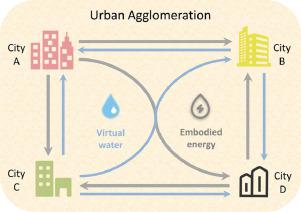Resources, Conservation and Recycling ( IF 13.2 ) Pub Date : 2020-08-27 , DOI: 10.1016/j.resconrec.2020.105113 Ziwen Liu , Qingxu Huang , Chunyang He , Changbo Wang , Yihang Wang , Kaixin Li

|
With rapid urban expansion and economic development, water shortages and high energy emissions at the regional scale pose critical challenges for urban agglomerations, resulting in quite intricate water-energy nexus. Although important, an assessment framework that can analyze interregional and intersectoral water-energy nexus among cities at the urban agglomeration scale is still lacking. Based on an environmentally extended multiregional input-output model and the concepts of virtual water and embodied energy, this study developed a new assessment framework for the water-energy nexus. By jointly considering the efficiency of input resources and the connections of interregional industrial sectors, this framework can be used to identify the key regions and sectors for water and energy saving. Using the Beijing-Tianjin-Hebei urban agglomeration as an example, the new framework revealed that electricity, gas and water supply industry in Zhangjiakou was a typical high water consumption-high energy consumption sector. Light industry and construction belong to a strong water-energy connection sector, whereas the water-saving measures only partially focus on reducing water consumption but promote energy consumption. In the future, it is imperative to improve the water-energy utilization efficiency of upstream sectors and promote the concept of green buildings with low environmental impacts. The developed framework can be further extended to capture food-energy-water nexus from regional to global scale, and can be used as an important toolbox to pinpoint the sector to realize the sustainable development goals of "clean water and sanitation" (SDG6) and "affordable and clean energy" (SDG7).
中文翻译:

城市群内的水能关系:结合多区域投入产出模型,虚拟水和具体能源的评估框架
随着城市的快速扩张和经济发展,区域规模的水资源短缺和高能源排放给城市群带来了严峻的挑战,从而导致了水能源关系的复杂化。尽管很重要,但仍然缺乏能够分析城市集聚规模的城市间区域间和部门间水能联系的评估框架。基于环境扩展的多区域投入产出模型以及虚拟水和具体化能源的概念,本研究开发了水能源联系的新评估框架。通过共同考虑投入资源的效率和区域间工业部门之间的联系,该框架可用于确定节水和节能的关键区域和部门。以京津冀城市群为例,新框架表明张家口的电力,燃气和供水行业是典型的高耗水高耗能行业。轻工业和建筑业是强大的水能连接部门,而节水措施仅部分集中在减少水消耗上,但促进了能源消耗。未来,必须提高上游行业的水能利用效率,并推广对环境影响小的绿色建筑理念。可以进一步扩展已开发的框架,以捕获区域到全球范围内的食品-能源-水关系,并且可以用作重要工具箱来指明该部门以实现“



























 京公网安备 11010802027423号
京公网安备 11010802027423号